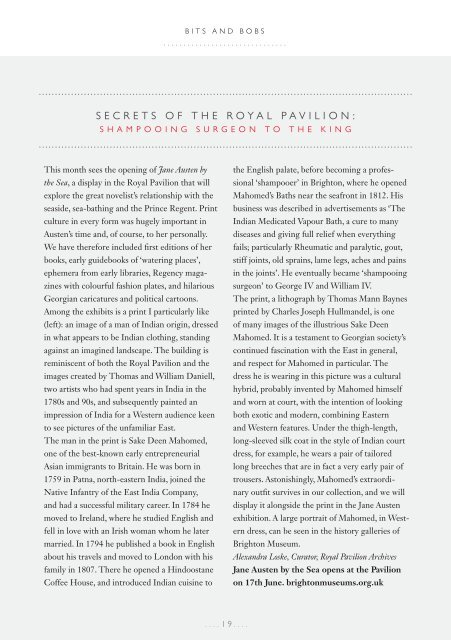Viva Brighton Issue #52 June 2017
Create successful ePaper yourself
Turn your PDF publications into a flip-book with our unique Google optimized e-Paper software.
BITS AND BOBS<br />
...............................<br />
SECRETS OF THE ROYAL PAVILION:<br />
SHAMPOOING SURGEON TO THE KING<br />
This month sees the opening of Jane Austen by<br />
the Sea, a display in the Royal Pavilion that will<br />
explore the great novelist’s relationship with the<br />
seaside, sea-bathing and the Prince Regent. Print<br />
culture in every form was hugely important in<br />
Austen’s time and, of course, to her personally.<br />
We have therefore included first editions of her<br />
books, early guidebooks of ‘watering places’,<br />
ephemera from early libraries, Regency magazines<br />
with colourful fashion plates, and hilarious<br />
Georgian caricatures and political cartoons.<br />
Among the exhibits is a print I particularly like<br />
(left): an image of a man of Indian origin, dressed<br />
in what appears to be Indian clothing, standing<br />
against an imagined landscape. The building is<br />
reminiscent of both the Royal Pavilion and the<br />
images created by Thomas and William Daniell,<br />
two artists who had spent years in India in the<br />
1780s and 90s, and subsequently painted an<br />
impression of India for a Western audience keen<br />
to see pictures of the unfamiliar East.<br />
The man in the print is Sake Deen Mahomed,<br />
one of the best-known early entrepreneurial<br />
Asian immigrants to Britain. He was born in<br />
1759 in Patna, north-eastern India, joined the<br />
Native Infantry of the East India Company,<br />
and had a successful military career. In 1784 he<br />
moved to Ireland, where he studied English and<br />
fell in love with an Irish woman whom he later<br />
married. In 1794 he published a book in English<br />
about his travels and moved to London with his<br />
family in 1807. There he opened a Hindoostane<br />
Coffee House, and introduced Indian cuisine to<br />
the English palate, before becoming a professional<br />
‘shampooer’ in <strong>Brighton</strong>, where he opened<br />
Mahomed’s Baths near the seafront in 1812. His<br />
business was described in advertisements as ‘The<br />
Indian Medicated Vapour Bath, a cure to many<br />
diseases and giving full relief when everything<br />
fails; particularly Rheumatic and paralytic, gout,<br />
stiff joints, old sprains, lame legs, aches and pains<br />
in the joints’. He eventually became ‘shampooing<br />
surgeon’ to George IV and William IV.<br />
The print, a lithograph by Thomas Mann Baynes<br />
printed by Charles Joseph Hullmandel, is one<br />
of many images of the illustrious Sake Deen<br />
Mahomed. It is a testament to Georgian society’s<br />
continued fascination with the East in general,<br />
and respect for Mahomed in particular. The<br />
dress he is wearing in this picture was a cultural<br />
hybrid, probably invented by Mahomed himself<br />
and worn at court, with the intention of looking<br />
both exotic and modern, combining Eastern<br />
and Western features. Under the thigh-length,<br />
long-sleeved silk coat in the style of Indian court<br />
dress, for example, he wears a pair of tailored<br />
long breeches that are in fact a very early pair of<br />
trousers. Astonishingly, Mahomed’s extraordinary<br />
outfit survives in our collection, and we will<br />
display it alongside the print in the Jane Austen<br />
exhibition. A large portrait of Mahomed, in Western<br />
dress, can be seen in the history galleries of<br />
<strong>Brighton</strong> Museum.<br />
Alexandra Loske, Curator, Royal Pavilion Archives<br />
Jane Austen by the Sea opens at the Pavilion<br />
on 17th <strong>June</strong>. brightonmuseums.org.uk<br />
....19....


















